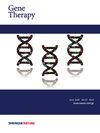RNAi targeting heparin cofactor II promotes hemostasis in a canine model of acquired hemophilia A
IF 4.5
3区 医学
Q1 BIOCHEMISTRY & MOLECULAR BIOLOGY
引用次数: 0
Abstract
Heparin cofactor II (HCII) is a critical anticoagulant protein that inactivates thrombin. In our previous mouse studies, we demonstrated that GalNAc-HCII, a small interfering RNA (siRNA) targeting HCII conjugated with N-acetylgalactosamine (GalNAc), exhibited promising therapeutic effects in hemophilia A mouse models. Further evaluation in large animal models, especially with FVIII inhibitors, is essential before GalNAc-HCII can proceed to clinical trials. In this study, we successfully established, for the first time, an acquired hemophilia A canine model by multiple intravenous injections of a rabbit-dog chimeric neutralizing anti-canine FVIII antibody. In the control group, the Beagle dogs exhibited spontaneous bleeding symptoms accompanied by prolonged activated partial thromboplastin time (APTT). After administration, GalNAc-HCII (0.8 and 1.6 mg/kg) demonstrated potent, dose-dependent, and durable HCII inhibitory effects. After 5 days, in normal dogs, GalNAc-HCII reduced HCII levels to 32.67% ± 3.07% and 10.62% ± 1.74% with 0.8 and 1.6 mg/kg GalNAc-HCII, respectively. In hemophilic dogs, GalNAc-HCII treatment significantly improved hemostatic function. Specifically, in the carotid artery thrombosis model, the thrombus formation time was shortened [29.7 ± 2.08 min (0.8 mg/kg) and 18.0 ± 1.0 min (1.6 mg/kg) vs. 40 min (control), P < 0.01]; in the knee joint puncture-induced bleeding model, joint bleeding and synovitis were alleviated; and in the saphenous vein bleeding model, the number of hemostatic events increased. Furthermore, repeated administration of GalNAc-HCII effectively reduced the prolonged APTT. This study demonstrates the efficacy of GalNAc-HCII in hemophilic dogs, suggesting it as a promising novel therapeutic option for patients with hemophilia, including those with FVIII inhibitors.

靶向肝素辅助因子II的RNAi促进犬获得性血友病a模型的止血。
肝素辅助因子II (HCII)是一种重要的抗凝血蛋白,可使凝血酶失活。在我们之前的小鼠研究中,我们证明了GalNAc-HCII,一种靶向HCII的小干扰RNA (siRNA)与n -乙酰半乳糖胺(GalNAc)结合,在血友病a小鼠模型中显示出有希望的治疗效果。在GalNAc-HCII进入临床试验之前,必须在大型动物模型中进行进一步评估,特别是FVIII抑制剂。本研究首次通过多次静脉注射兔-犬嵌合中和抗犬FVIII抗体成功建立犬获得性血友病A模型。在对照组中,Beagle犬表现出自发性出血症状,并伴有活化的部分凝血活素时间(APTT)延长。给药后,GalNAc-HCII(0.8和1.6 mg/kg)显示出有效的、剂量依赖性的、持久的HCII抑制作用。5天后,在正常犬中,以0.8和1.6 mg/kg GalNAc-HCII分别使HCII水平降低至32.67%±3.07%和10.62%±1.74%。在血友病犬中,GalNAc-HCII治疗可显著改善止血功能。其中,颈动脉血栓形成模型的血栓形成时间缩短,分别为29.7±2.08 min (0.8 mg/kg)和18.0±1.0 min (1.6 mg/kg),对照组为40 min
本文章由计算机程序翻译,如有差异,请以英文原文为准。
求助全文
约1分钟内获得全文
求助全文
来源期刊

Gene Therapy
医学-生化与分子生物学
CiteScore
9.70
自引率
2.00%
发文量
67
审稿时长
4-8 weeks
期刊介绍:
Gene Therapy covers both the research and clinical applications of novel therapeutic techniques based on a genetic component. Over the last few decades, significant advances in technologies ranging from identifying novel genetic targets that cause disease through to clinical studies, which show therapeutic benefit, have elevated this multidisciplinary field to the forefront of modern medicine.
 求助内容:
求助内容: 应助结果提醒方式:
应助结果提醒方式:


